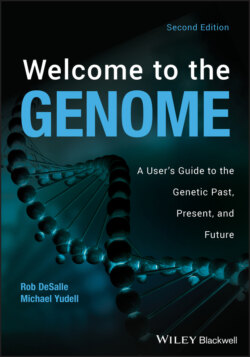Читать книгу Welcome to the Genome - Michael Yudell - Страница 25
RESEARCH MILESTONE 4: SEEING GENES
ОглавлениеSanger’s sequencing of insulin’s amino acids, the cracking of the genetic code, and Kornberg’s work on DNA polymerase were all technologies that would someday lead to the sequencing of a whole genome. But the ever‐increasing knowledge of the molecular basis of inheritance could not reach its full potential for both scientific and biomedical research without techniques to sequence genes quickly and accurately. So we now turn from deciphering the interiors of the cell to technologies that capitalized on these discoveries and enhanced our ability to see the most fundamental mechanisms of heredity. By the 1970s laboratories around the globe were focused on finding ways to better characterize, at the molecular level, genes and their component parts.
Oxford University biologist Edward Southern revolutionized molecular biology in 1975 with a method that came to be known as the Southern blot. (26) Southern blots allowed geneticists to locate and look at DNA and genes within a genome by capitalizing on the following characteristics of DNA. First, DNA is a negatively charged molecule; thus when electricity is present, it can hitch a ride on a current—it migrates to the positive terminal in an electric field.
Second, DNA molecules are small and can be separated by passing them through a porous gel made from either agarose (extracted from seaweed) or acrylamide (a synthetic polymer). The size of the DNA fragment, the strength of the current, and the concentration of acrylamide or agarose in the gel mixture dictate how fast molecules will pass through it. In fact, the concentration of an acrylamide gel can be adjusted to such a fine degree that DNA molecules of one base pair difference in length can be distinguished. Third, one fragment of DNA can be used to find another. This process, known as DNA hybridization, activates one strand of a double helix to search for the other strand, to reform hydrogen bonds and make a new double helix.
Hybridization doesn’t have to be perfect; only 60–70% of the two strands of a helix must match for the two strands to stick together.
Southern created a technique whereby a small piece of an organism’s genome can be arranged by size along an agarose gel. The technique then involves the transfer of DNA from gels onto nitrocellulose membranes. To detect where a specific gene is, a fragment of the gene of interest is labeled with radioactivity and then hybridized (attached) to the DNA on the nitrocellulose. Radioactive molecules hybridizing to the DNA on the filter emit particles that react with photographic film and can therefore be seen as a dark spot on the film. With his blot, Southern solved the problem of finding a genetic needle in a genomic haystack. Techniques were later developed to similarly isolate RNA molecules (jokingly named Northern blotting) and protein molecules (named Western blotting). (27)
Figure 2.4 DNA hybridization occurs when a single strand of a double helix finds a complementary strand to form a new double helix.
Credit: Exhibitions Department, American Museum of Natural History
